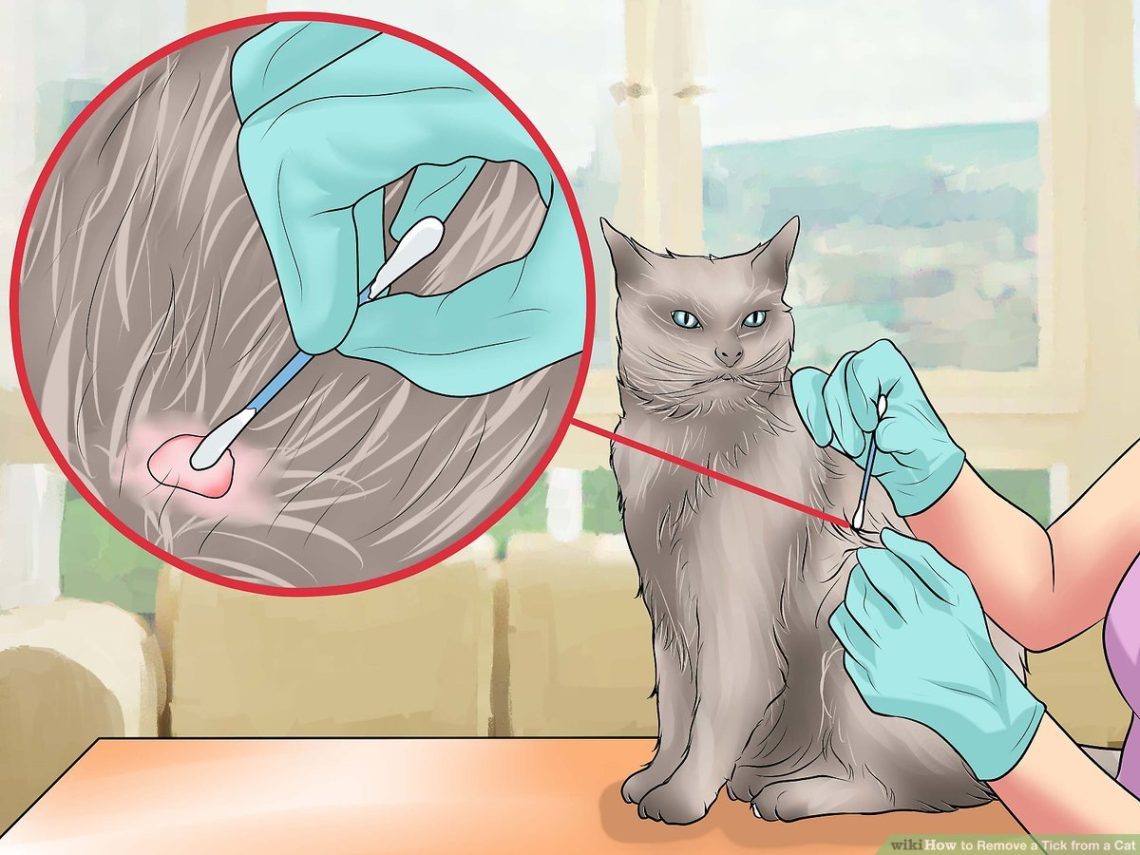
ווי צו באַזייַטיקן אַ טיקען פון אַ קאַץ און אַ קאַץ מיט אַ פאָדעם, קרוק אָדער פּינצעט
Every spring, parasites appear in the forest, park area and even on the lawn near the house, which are dangerous for both people and animals. It’s about ticks. Cats that walk on the street can bring such a parasite on themselves and, most often, already attached. Therefore, their owners should know how to find and properly remove a tick from a cat.
ינהאַלט
How to find the parasite
After each walk, the animal is desirable check for ticks. It looks like a flat brown drop, XNUMX to XNUMX millimeters in size. After the parasite has drunk blood, its size can increase to one and a half centimeters, and it itself becomes like a gray wart. Looking closely, you can see the hooked legs and the point of the head.
The sooner the parasite is detected, the better. Once on the skin, he does not immediately dig into it, but within two hours he can look for a suitable place to bite. That’s why examination of the cat immediately after arrival her home might give you a chance to find a tick before it digs into your skin.
- Most often, parasites dig into the skin of the armpits, thighs, abdomen and behind the ears. In cats, they prefer the groin area.
- Having found a suitable place, the tick cuts the tissues and advances its proboscis as deep as possible.
- With the help of a mouth apparatus with teeth and hooks, the parasite is securely fixed in one position and begins to alternately suck out blood and lymph.
- In the process of feeding, the tick injects special enzymes into the wound that anesthetize. Due to this, the animal does not show any anxiety, as it simply does not feel the presence of the parasite.
Therefore, in order to detect a tick in a cat, it should be carefully examined, felt or combed against the coat.
How to remove a tick from a cat at home
There are several ways to remove pests.
Removal with thread.
To do this, a loop is made from a coarse thread, which is put on the pest closer to the skin. Then both ends of the thread are compressed with fingers and the tick is unscrewed by turning it counterclockwise.
Crochet.
Externally, the hook looks like a curved fork with two cloves, which are placed so that the parasite is in the middle. Next, the tick is twisted out of the skin of the animal. These hooks are usually sold in pet stores. If it is not possible to buy them, then you can try to get the pest in other ways or contact your veterinarian.
Removal with special tweezers or surgical forceps.
These tools are curved, so they can easily capture the tick close to the proboscis. After that, the insect is clamped and pulled out by rotational movements counterclockwise. You can remove the pest by making two or three turns.
It is impossible to jerk sharply, since only part of the tick can be torn off, and its proboscis will remain inside. This can lead to the development of tissue necrosis and its further inflammation.
After removing the parasite, the bite wound on the cat’s skin must be treated with disinfectants.
- You can apply a small amount of antibiotic ointment.
- A small amount of inflammation may develop at the bite site, which will help remove a small amount of hydrocortisone spray.
- Complete healing of the wound may take about a week.
- Within three weeks, the behavior of the pet will need to be observed. If the cat feels unwell, becomes lethargic, has a temperature and itches, then as soon as possible, you should take it to the veterinarian.
After tick removal don’t try to crush it, crush with your fingers, or dispose of down the drain. They are very tenacious, therefore, in order to kill the parasite, it must be burned or placed in a jar of alcohol. And it is best to take the tick for analysis to find out whether it was a carrier of the disease or not.
How not to pull out a tick
You can often hear the advice that the insect is easily removed using sunflower oil or alcohol. It is not recommended to do this, since the tick will not leave its victim on its own, and due to irritation, it will release even more enzymes that contribute to the infection of the animal’s body.
In addition, veterinarians do not advise for extracting a tick from a cat:
- Crush the protruding end of the parasite on the body of the pet.
- Pick out the insect with a needle.
- Pull out the tick with your fingers.
- Burn it with a cigarette.
- Apply caustic liquids to the bite site, such as ammonia, gasoline, kerosene.
Antiparasitics for cats
It is impossible to completely protect an animal from a tick bite, but special preventive measures will help to minimize the risk.
Tick Collars.
They are suitable for healthy adult cats and are a strip impregnated with a special tick repellent.
Collar pros:
- the means with which the strip is impregnated are valid for three to five months;
- the collar only needs to be put on the animal, so it is easy to use;
- has such a prophylactic low cost.
קאָנס:
- can cause local irritation, in the form of hair loss in the neck and dermatitis;
- have high toxicity, therefore they are not recommended for pregnant and sick cats, as well as kittens;
- there is a high risk of poisoning an animal that gnaws or licks the collar.
Mite sprays.
These are quite effective, but not very convenient to use means.
- It should be distributed throughout the cat’s coat, avoiding contact with the nose, mouth, eyes and genitals.
- The cat at this time should stand quietly, which is quite difficult to achieve.
- It is impossible to allow the animal to begin to lick itself immediately after applying the composition. The pet will have to be kept until the drug dries.
- Possible signs of intoxication: salivation, salivation, vomiting.
Today, Frontline is considered the safest spray, which is quite expensive.
טראפנס פון טיקס.
The drug is applied to the skin of the animal in the region of the shoulder blades, absorbed into its upper layers and repels or even kills parasites.
- High-quality preparations can be used already for eight-month-old kittens and pregnant cats.
- Drops containing heavy pesticides should not be applied to sick or pregnant cats and kittens under three months of age.
For the entire season, drops should be used once a month.
Before you start using any antiparasitic agent, you must carefully study the instructions. Sometimes the active ingredient can cause toxicity, at the first sign of which you should immediately consult a veterinarian.
Caring owners of cats and cats should know all these preventive measures and, before letting the pet go for a walk, protect it in one of the ways.





